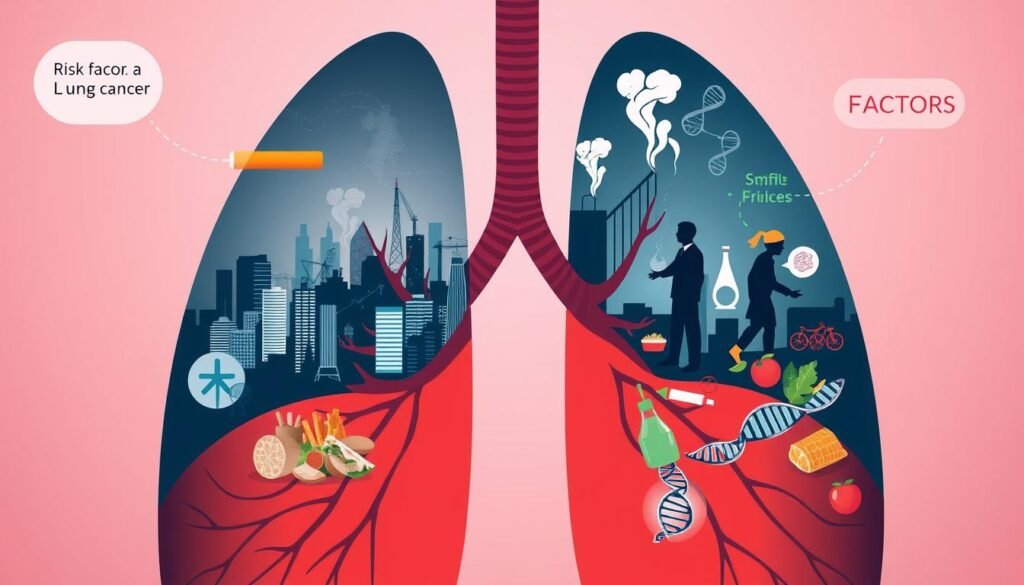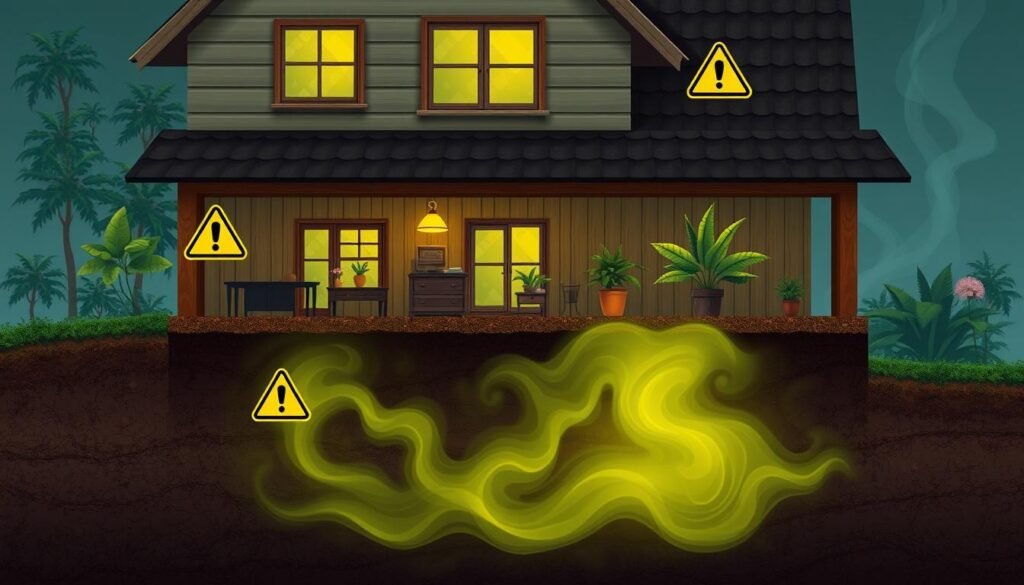Did you know that smoking causes 87% of lung cancer deaths in the U.S.? This fact highlights the urgent need for ways to prevent lung cancer. Tobacco is to blame for about 90% of lung cancer cases in men and 80% in women.
Making smart choices helps lower the risk of this terrible disease. This guide provides tips on adopting a healthy lifestyle and finding help to quit smoking. Knowing about environmental and genetic risks also helps in preventing lung cancer. Let’s learn about the key steps to lead a healthier life without lung cancer.
Key Takeaways
- Smoking accounts for the majority of lung cancer deaths.
- Quitting smoking significantly reduces lung cancer risk.
- Healthy diets rich in fruits and vegetables may help lower risk.
- Radon exposure in homes is a critical lung cancer risk factor.
- Regular physical activity can reduce lung cancer risk, even for smokers.
- Environmental pollutants increase the likelihood of developing lung cancer.
The Importance of Prevention in Lung Cancer
Lung cancer is a major health issue. It is the top reason for cancer deaths in men and women. Around 25% of all deaths from cancer come from lung cancer.
Smoking has a huge link to lung cancer. It causes 87% of lung cancer deaths in men and 70% in women. This shows how important it is to know about health risks. Also, secondhand smoke kills over 7,000 nonsmokers every year from lung cancer.
Lung cancer is the cancer we can prevent the most around the world. By taking steps to prevent it, we can lower how often it happens. Eating more fruits and vegetables each day can help lower the risk. Just adding 100 grams more each day can make a big difference.
Preventing lung cancer isn’t just about personal choices. It’s also about teaching others in the community. Knowing the risks of smoking and the good points of quitting can greatly reduce lung cancer cases. Screening for lung cancer early is especially important for those at high risk.
| Statistical Data | Impact |
|---|---|
| Lung cancer accounts for 25% of all cancer-related deaths | Highlight the need for preventive measures |
| 87% of lung cancer deaths in men attributed to smoking | Emphasizes smoking cessation efforts |
| Over 7,000 adults die from secondhand smoke exposure | Calls for increased policy and health awareness |
| Lung cancer is the most preventable cancer | Encourages proactive health initiatives |
| Fruits and vegetables reduce lung cancer risk | Promotes healthy eating habits |
Understanding Lung Cancer Risk Factors
Lung cancer is a major health threat with many risk factors. Smoking is the biggest risk, causing most lung cancer deaths in the U.S. It affects not just smokers but also those around secondhand smoke.

Environmental hazards like radon are also big risks. Radon is a top cause of lung cancer, especially in smokers. Being in workplaces with harmful substances like asbestos can also increase the risk.
Having a family history of lung cancer raises your risk too. This shows how genetics are linked to this disease. Certain dietary choices, like beta-carotene supplements, could make things worse for smokers.
Knowing these risk factors is key to prevention. It’s crucial to understand everything from smoking and radon exposure to genetics. This knowledge can help people make better choices for their lung health.
How Can Lung Cancer Be Prevented
Lung cancer is the top cause of cancer deaths around the globe. Smoking is the main reason for this sad fact. To fight this disease, we must use strong prevention methods. Staying away from all types of tobacco is crucial. Quitting smoking can greatly reduce your lung cancer risk. It also makes you healthier overall.
Avoiding Smoking and Tobacco Products
Quitting smoking is the most important step to prevent lung cancer. If you stop smoking, you can greatly lower your risk as time goes on. Even long-time smokers can find help to quit. There are many tools available, like counseling and medication. Steering clear of tobacco is key to fighting cancer. It helps not just the smoker but also everyone around them.
The Impact of Secondhand Smoke
Being around smoke when you don’t smoke is very risky. It’s especially bad for kids and pregnant women. This secondhand smoke is full of dangerous chemicals that can cause lung cancer and other health issues. Making places smoke-free helps protect everyone. It’s important to push for bans on smoking in public areas. When more people understand how bad secondhand smoke is, we can work together. This ensures safer spaces for all.
| Method | Description | Benefits |
|---|---|---|
| Avoiding Tobacco | Complete abstinence from all tobacco products. | Lower risk of lung cancer and improved overall health. |
| Smoking Cessation | Utilizing support systems to quit smoking. | Significant reduction in lung cancer risk over time. |
| Secondhand Smoke Reduction | Implementation of smoke-free policies in shared spaces. | Increased protection for non-smokers from harm. |
Radon Exposure and Its Risks
Radon is a radioactive gas that comes from uranium decay in the soil. It’s invisible and has no smell but is a big risk for lung cancer. This gas can build up in homes, especially if they don’t have good airflow. It’s very important for people who own or rent homes to know about these dangers.
What is Radon?
Radon is the second biggest cause of lung cancer in the U.S. each year. It’s behind 15,000 to 22,000 cases of lung cancer annually. The EPA says that around 1 in 15 homes could have high levels of radon. If you also smoke, radon is even more dangerous. It increases your lung cancer risk by 25 times. Even non-smokers can get lung cancer from radon, making up about 10 percent of cases.
Testing and Reducing Radon Levels in Homes
It’s very important to test your home for radon. The EPA suggests fixing your home if radon levels are higher than 4.0 pCi/L. You can cut radon inside your home by more than half with the right steps. For example, venting systems help lower radon further. Testing and fixing radon levels can lower your lung cancer risk. If you stop smoking too, your health can improve a lot. To learn more about radon, check out this resource.

Workplace Safety and Cancer Prevention
Keeping workers safe is key in fighting job-related cancer. This is especially true when it comes to lowering the risk from cancer-causing agents in the workplace. Jobs in various industries can expose workers to dangerous substances like asbestos, heavy metals, and pesticides. These substances can greatly raise the risk of cancer. It’s crucial for companies to follow strict safety rules to make their workplaces safer.
Following health and safety rules is important to cut down on dangerous exposure. These measures can help lower cases of lung cancer in the workforce. Efforts to prevent cancer include checking air quality often and giving workers the right safety gear. By teaching employees about the dangers of workplace carcinogens, companies can build a culture that values safety and awareness.
Research shows how important it is to deal with cancer-causing agents at work. For example, one study linked certain pesticides to lung cancer. This underlines the need for careful safety practices in farming. Studies have also shown that workers in industrial settings face more health risks from chemicals. Such findings stress the need for companies to keep looking for cancer risks and to work on preventing them.
Companies can play a big part in reducing work-related cancer risks by educating workers, encouraging healthy habits, and staying proactive. To learn more about how to prevent cancer at work, check out cancer prevention resources.

| Factor | Risk Level | Prevention Measures |
|---|---|---|
| Asbestos Exposure | High | Proper ventilation, use of protective gear |
| Heavy Metals | Moderate | Regular monitoring and workplace safety audits |
| Pesticide Use | High | Proper application techniques, employee education |
| Industrial Chemicals | Varying | Material Safety Data Sheets (MSDS), training |
Working together with health organizations and joining cancer awareness programs help fight cancer in the workplace. These joint efforts are important. They reduce the risk of lung cancer and work towards healthier job sites for everyone.
Healthy Lifestyle Choices
Choosing a healthy lifestyle is key to preventing lung cancer and boosting well-being. Eating right and staying active can lower your cancer risk. These steps are big in fighting cancer.
The Role of a Balanced Diet
Eating a variety of fruits and vegetables may cut your lung cancer risk. This is true even if you’ve smoked before. Good food helps you deal with cancer treatment side effects like nausea.
It keeps lung cancer patients strong and fights infections. Healthy eating can make life better during treatment. It’s very important.
Physical Activity and its Benefits
Exercise helps lung cancer patients in many ways. It fights fatigue, boosts mood, and helps you keep a healthy weight. Being active improves lung health and overall fitness, vital for recovery.
Joining groups like the American Lung Association Lung HelpLine or Inspire.com’s Lung Cancer Survivors Community is great. They encourage activity and connection.
Healthy habits could prevent nearly half of all cancer cases and deaths. A diet focused on cancer prevention and regular exercise can make a huge difference. They lower the risk of getting ill in the future.
For more on detecting lung cancer early and making screening choices, check out these guidelines.
Avoiding Environmental Carcinogens
Many environmental factors contribute to lung cancer. It is crucial to reduce exposure to pollution for lung health and safety. Poor air quality is often the result of emissions from industries, vehicles, and household cleaners. By understanding and tackling these hazards, we can cut the risk of lung cancer and respiratory diseases.
To protect against harmful environmental elements, we need to take steps. Pay attention to air quality alerts and stay indoors when pollution is high. Pushing for better air quality policies also helps protect communities. Supporting cleaner emissions and green choices can make our environment healthier.
Here is a comparison of common environmental carcinogens and their potential impact on lung cancer risk:
| Carcinogen | Source | Impact on Lung Cancer |
|---|---|---|
| Radon | Natural uranium decay in soil | Leading cause of lung cancer among non-smokers |
| Asbestos | Insulation materials, roofing | Increased risk of lung cancer and mesothelioma |
| Air Pollution | Vehicle emissions, industrial discharge | Known to aggravate lung cancer risk |
| Secondhand Smoke | Exposure from smokers | Increases risk significantly, especially in non-smokers |
We can support clean air initiatives and also look after our surroundings. For tips on preventing lung cancer, visit reputable health organizations. Learn about cancer prevention strategies from experts.
Family History and Genetic Factors
Family ties play a big role in lung cancer risks. If your relatives have had it, your own risk might rise. Studies show a two to three times higher risk for those with affected family members. Yet, family genetics only explain about 8% of lung cancer cases. Still, knowing your family’s health history helps in weighing your risk.
Genes also matter when it comes to lung cancer, especially the non-small cell lung cancer (NSCLC). Certain mutations almost double the chances of getting lung adenocarcinomas. That’s why gene testing is crucial. Through genetic testing, you can learn about your risk and how to manage it.
However, don’t forget that lifestyle and environment affect lung cancer risks too. Most lung cancers are linked to smoking, secondhand smoke, and other pollutants. Knowing this, people with a family history can take steps to lower their risks. Lifestyle changes can make a big difference.